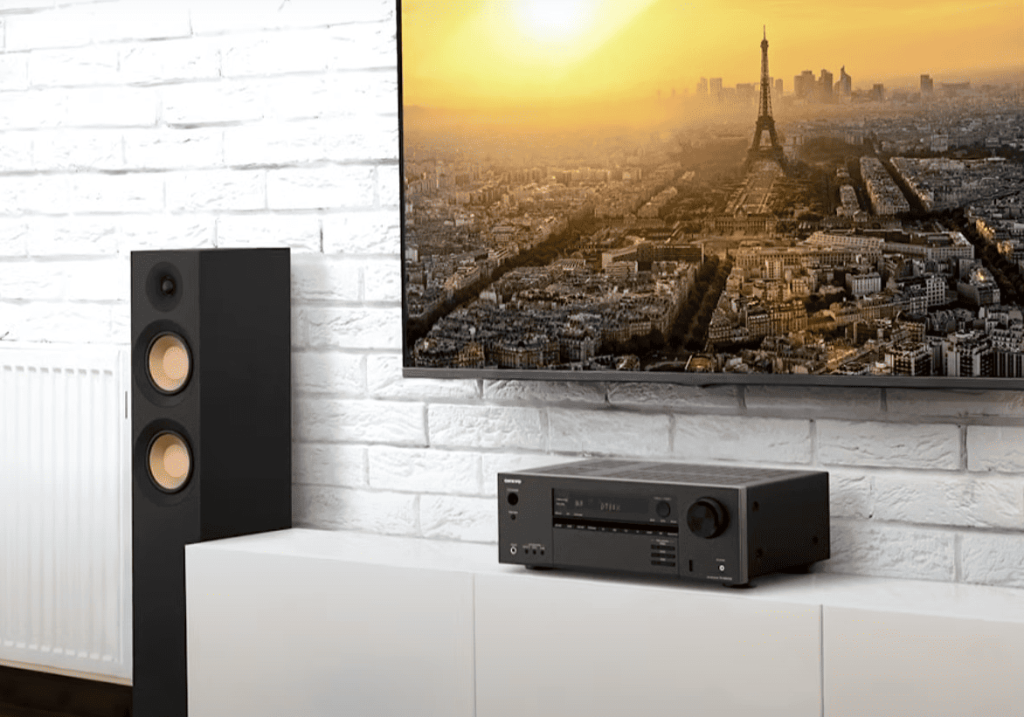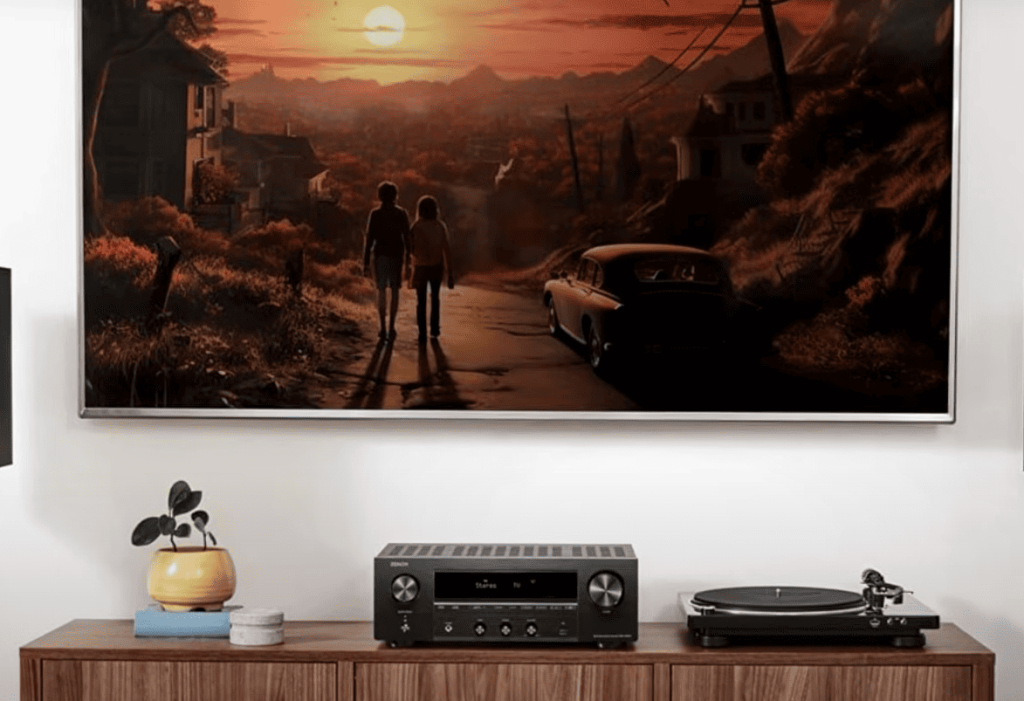Did you know the company behind your home theater’s sound has been shaping audio tech since before the first radio broadcast? What started as a small Tokyo-based electronics shop in 1910 now powers immersive Dolby Atmos experiences in millions of living rooms worldwide.
This guide unravels the evolution of a brand that’s spent over a century perfecting sound reproduction. You’ll see how strategic partnerships – like their 1947 merger with Japan Denki Onkyo – fueled innovations that transformed bulky amplifiers into sleek, feature-packed hubs for modern entertainment systems.
We’ll explore how each generation of equipment responded to cultural shifts. From vinyl’s golden age to today’s 8K streaming era, the brand’s engineering philosophy balances cutting-edge specs with user-friendly design. Recent developments like HDMI 2.1 integration and voice control compatibility show their commitment to staying ahead of home tech trends.
Understanding this timeline helps explain why certain models became industry benchmarks. Whether you’re hunting for vintage gear or comparing the latest specs, you’ll discover what makes these components enduring favorites among audiophiles and casual listeners alike.
Key Takeaways
- Founded in 1910, the brand merged with key industry players to expand its audio expertise
- Historic amplifier designs laid groundwork for modern surround sound systems
- Corporate acquisitions directly influenced technological advancements in home theater
- Annual model updates reflect evolving entertainment formats and connectivity standards
- Current flagship units support 8K video and advanced gaming features
Introduction to Denon’s Audio Legacy
Imagine a world where music couldn’t be captured – until a visionary company changed everything. In 1910, this audio pioneer introduced Japan’s first playable wax cylinders, letting people experience recorded sound for the first time. Their early work with professional-grade equipment laid the groundwork for today’s immersive home theaters.

Over time, the brand expanded its expertise across both consumer and specialty markets. You’ll find their tech in everything from sleek wireless headphones to advanced Blu-ray players. But their true claim to fame? Precision-engineered components that turn living rooms into concert halls.
“Great sound isn’t accidental – it’s engineered through decades of trial and refinement.”
What sets them apart is a relentless focus on clarity and detail. Every product undergoes rigorous testing to meet strict performance standards. This commitment to quality ensures crisp dialogue in movies and rich basslines in music, whether you’re using budget gear or premium systems.
Through countless innovations, they’ve shaped how we experience audio. From vinyl’s golden age to today’s wireless streaming, their solutions adapt to cultural shifts while maintaining core principles. It’s this balance of tradition and progress that keeps enthusiasts coming back generation after generation.
History and Milestones of Denon Innovation
Ever wondered how a century-old audio brand became a household name? The story begins with an American visionary in Tokyo. Frederick Whitney Horn founded Nippon Chikuonki Shoukai in 1910, creating Japan’s first record players and wax cylinders.
Early Beginnings and Founding Moments
Strategic alliances shaped the company’s first years. By 1912, a merger with Japan-US Recorders Manufacturing boosted production capabilities. This move laid the groundwork for future breakthroughs in sound technology.
The 1928 rebrand to Japan Columbia Recorders marked a turning point. Introducing the Columbia label established their reputation in premium audio equipment. Post-war restructuring in 1946 set the stage for their most iconic identity shift.
Key Mergers and Brand Evolution
1947 brought a game-changing partnership with Japan Denki Onkyo. This union birthed the modern brand we recognize today, merging engineering expertise with cutting-edge design principles.
Fast-forward to 2002: the D&M Holdings merger combined two audio giants. This collaboration expanded resources for developing advanced home theater components. The 2017 acquisition by Sound United LLC injected fresh momentum, ensuring continued leadership in evolving markets.
“Our mergers aren’t about size – they’re about perfecting the listening experience through shared knowledge.”
Each strategic decision across 113 years has refined their approach to audio engineering. From turntables to surround sound systems, these partnerships directly influenced the quality and features users expect today.

Exploring Denon Receiver Models by Year
From vinyl enthusiasts to gamers, sound systems have adapted to meet every era’s demands. Let’s explore five groundbreaking moments that reshaped home entertainment technology.
| Year | Breakthrough | Key Features |
|---|---|---|
| 1971 | Hi-Fi Amplifier Debut | Pure signal paths 120W power output |
| 1988 | AV Amplifier Launch | Composite video support Dolby Pro Logic |
| 1999 | THX-EX System | 7.1 channel processing Cinema-grade calibration |
| 2018 | 13.2 Channel Unit | IMAX Enhanced DTS:X Pro |
| 2020 | 8K Video Support | 4K/120Hz pass-through ALLM/VRR gaming |
The 1971 amplifiers set new standards for clarity. These components used direct-coupled circuits to eliminate distortion, a technique still valued today.
When home theaters exploded in popularity, 1988’s solutions became essential. They handled both music and movie audio with equal precision. “We didn’t just amplify sound – we redefined how families experience media,” noted a product engineer from that era.
Modern systems build on this legacy. The 2020 lineup’s 8K-ready HDMI ports future-proof installations while maintaining audiophile-grade performance. Each advancement reflects careful listening to what users need next.
Technological Advancements and HDMI 2.1 Developments in Denon Receivers
What if your entertainment system could adapt to tomorrow’s tech today? The latest HDMI 2.1 standard answers this challenge with groundbreaking capabilities. This upgrade triples data transfer speeds, pushing bandwidth to 48 gigabits per second – enough to handle 8K video at 60Hz.

HDMI 2.1 Features and Their Impact
Modern components now support features that transform how you interact with content. Automatic Low Latency Mode (ALLM) detects gaming consoles and switches settings for split-second responsiveness. One user noted: “It’s like my system reads my mind – no more frustrating input lag during boss fights.”
Enhanced Audio Return Channel (eARC) simplifies setups by streaming lossless Dolby Atmos through a single cable. Variable Refresh Rate (VRR) keeps fast-paced action smooth, while Quick Media Switching erases those awkward pauses between streaming services.
Connectivity Upgrades for Modern Systems
Future-ready ports ensure your gear stays relevant. The 2020 lineup introduced full 8K compatibility, letting you enjoy crystal-clear visuals as content evolves. Key improvements include:
- 4K/120Hz pass-through for buttery-smooth gaming
- Dynamic HDR optimization for vivid contrast
- HDMI-CEC control across multiple devices
These updates create a seamless bridge between high-end video and immersive audio. Whether you’re battling aliens or binge-watching documentaries, every detail stays sharp and perfectly synchronized.
Understanding AV Receiver Features for Home Theater
Modern home theaters rely on an unsung hero behind the scenes. The audio video hub at their core juggles multiple tasks while staying invisible. Think of it as your entertainment system’s brain – coordinating sights and sounds without missing a beat.
This central command center does more than just amplify music. It processes surround sound formats, switches between gaming consoles and streaming devices, and fine-tunes dialogue clarity. “It’s like having a tech-savvy conductor orchestrating every element,” one movie buff remarked.
Connectivity forms its superpower. You’ll find ports for:
- 4K/8K media players
- Next-gen gaming rigs
- Satellite boxes
- Wireless speakers
Advanced models transform chaotic cable nests into streamlined setups. They automatically adjust audio levels for different content – explosions shake the room while whispered conversations remain crystal-clear. Smart integration lets you control everything through voice commands or a single app.
The best systems grow with your needs. Future-ready HDMI 2.1 ports handle emerging video standards, while room calibration tech optimizes sound for your space. Whether you’re hosting game night or binge-watching dramas, this versatile hub keeps the experience seamless.
Performance, Quality, and Value in Denon Receivers
Finding the perfect home theater setup doesn’t require emptying your savings account – if you know where to look. Modern audio components offer remarkable capabilities at various price levels, with smart engineering bridging the gap between premium performance and practical budgets.
Smart Spending for Superior Audio
The $1,700 mark often separates well-equipped systems from overkill solutions. Beyond this point, improvements become subtle unless you’re driving specialty speakers or building a dedicated theater room. One audio engineer explains: “Our goal is delivering 95% of flagship performance at half the cost through intelligent component choices.”
Power ratings only reveal part of the story. A 100-watt unit with clean amplification often outperforms cheaper 150-watt alternatives during dynamic movie scenes. Look for systems maintaining clarity at high volumes without harshness or distortion – this separates temporary thrills from lasting satisfaction.
Build durability matters as much as specs. Quality capacitors, robust heat sinks, and precision-tuned circuits ensure years of reliable service. These hidden investments protect your purchase long after the warranty expires.
Focus on features you’ll actually use. Need 4K gaming support? Prioritize HDMI 2.1 ports. Streaming music daily? Built-in Wi-Fi beats extra dongles. Matching capabilities to your habits prevents paying for unused tech while keeping upgrades manageable.

Comparing Denon Receiver Models: Past, Present, and Future
How do sound systems stay relevant across decades? The answer lies in smart evolution. Early units focused on raw power and durability, with simple stereo setups dominating living rooms. Today’s options prioritize connectivity, supporting everything from vintage vinyl to cloud playlists.
Modern models shine with upgrade-friendly designs that adapt to new tech. Wireless streaming and voice controls now sit alongside classic RCA inputs. This balance lets users mix retro gear with cutting-edge gaming consoles effortlessly. One audio designer notes: “We build bridges between old-school charm and tomorrow’s possibilities.”
Looking ahead, expect smarter integration. Future systems might auto-calibrate to room layouts or sync with AR glasses. Yet core principles remain – clear dialogue reproduction and immersive bass response still define quality across generations.
Whether comparing 90s workhorses to current releases, the pattern holds: each model range solves its era’s challenges while respecting timeless listening values. Choose upgrades that honor your favorite media formats yet leave room to grow.

